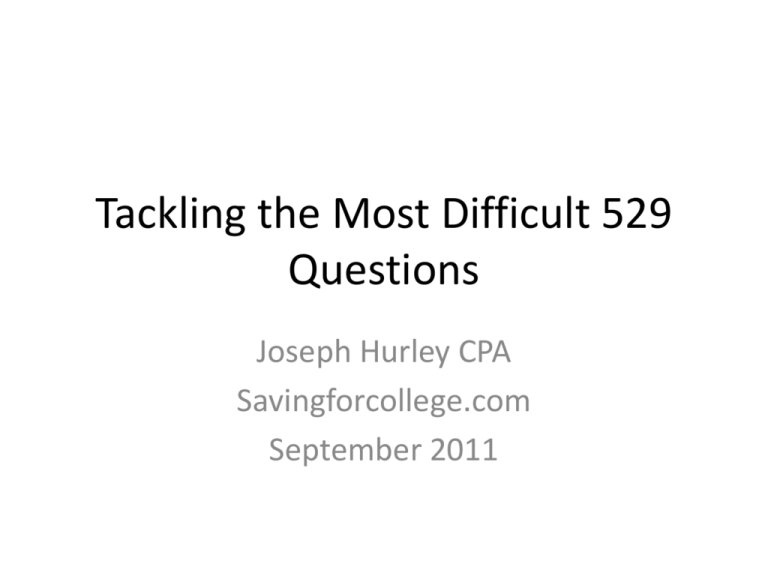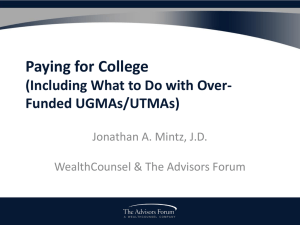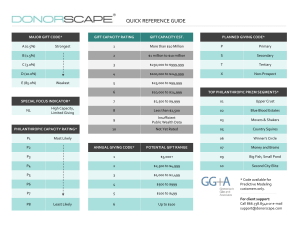
Tackling the Most Difficult 529
Questions
Joseph Hurley CPA
Savingforcollege.com
September 2011
529 Universe
95 savings programs
60 direct-sold 529 savings programs
35 advisor-sold 529 savings programs
Over 3,000 portfolios
20 prepaid tuition programs
10 state-sponsored 529
1 state-sponsored non-529 (MA U.Plan)
1 institutional (PC 529)
8 “closed” prepaid programs
Industry Growth
• $149.8B at 6/30/11
– Up 2.4% from 3/31/11
– Up 27% from 6/30/10
• 2/3rds of assets are in age-based portfolios
Source: Data compiled by Financial Research Corporation (FRC) for the College
Savings Foundation (CSF)
10-Year Growth of 529 Plan Assets
529 Asset Breakdown
by Distribution Method, 2003-2010
100%
90%
80%
70%
62%
61%
61%
60%
59%
38%
39%
39%
40%
41%
53%
52%
51%
47%
48%
49%
60%
50%
40%
30%
20%
10%
0%
2003
2004
Source: Financial Research Corp. (FRC)
2005
2006
2007
Direct
Advisor
2008
2009
2010
Legislative Status
• H.R. 529 introduced February 2011
1.
2.
3.
4.
–
Reinstates computer technology as QHEE
Allows 4 investment changes/year
Up to $600 in tax-free employer matching
Make 529 contributions eligible for Saver’s Credit
Prospects unclear, some parts may attach to other
bills
• Budget deficit negotiations
–
No indication that 529 plans will be targeted
“Why can’t you just tell me which is
the best 529 plan?”
Consider:
• Confidence in investment manager
– Single-manager versus multi-manager
• Investment menu
• Investment performance
– Savingforcollege.com Quarterly 529 Rankings
• Fees and expenses
– Savingforcollege.com Fee Study
• Flexibility – e.g. owner changes
• Wholesaler knowledge/resources
• In-state benefits?
“Why shouldn’t I use a Roth IRA
instead of a 529 to save for college?”
Roth Pros
• No tax/penalty on withdrawal of contributions
– Contributions come out first with Roth
– Can use for any purpose versus the 10% penalty
with 529 plan
• Early distribution penalty waived with
qualified higher education expenses
• Availability of self-directed accounts
• Retirement accounts not reported as assets on
FAFSA
Roth Cons
• Who cares that the IRA penalty is waived?
– Earnings are taxed versus tax-free 529
• Can’t put in very much
– $5-6,000 annual Roth contribution limit versus
$300,000+ with 529
– Earned income requirement
• Using for college means not using for retirement
• IRA distributions are added back as based-year
income on the FAFSA
– Assessed as high as 50% in computing EFC
“How can I convince the Grandmother
to turn over her 529 plan to me?”
You could ask her:
• Don’t you trust me with the account?
• Don’t you realize what will happen if you ever
have to apply for Medicaid?
– State will require use of 529 for medical expenses
• Don’t you realize what will happen if Sally
becomes eligible for need-based financial aid?
– Distributions from grandparent-owned 529 must
be added back to student’s base-year income
If she says MYOB
• Ask to use her account first in paying college
bills
– Reduces the risk of her circumstances changing
• Ask her to use her account last in paying
college bills
– Distributions for final year of college will not
impact aid
• Ask her again next year for owner change
“I have two children. Should I set up
one 529 account or two?”
Suggest 2 accounts:
• Two $13K annual gift exclusions instead of one
• Tailor the asset allocation for each child’s age
• Better family bookkeeping
– No second guessing if account owner dies
– No hard feelings if “left out” child opens the 529
statements
• Could possibly save $10 - $50 per year in
annual account maintenance with 1 account
“I’ve heard you have 33 different 529
plans. Should I open multiple plans for
my child?”
Reasons for two or more plans:
• Investment manager diversification
• Prefer in-state 529 only for its limited tax
benefit
– Additional amounts to a better or cheaper 529
• See how different 529 plans are run
• Asset class segregation
– Each account has its own earnings ratio
– Minimize risk of future taxes/penalties by leaving
lower-earning 529 for last
Reasons for just one plan:
• Much easier, less confusing, less paperwork
• Can usually find sufficient diversification in
one 529 plan
• Asset class segregation usually isn’t worth the
effort
– Expect it all to come out tax-free anyway
“What is this I hear about 529
distributions being taxed even when
used for college?”
Tax coordination rules (aka antidouble-dipping)
• Tax credit expenses reduce the pool of 529eligible expenses
– QHEE versus AQHEE (see IRS Publication 970)
• American Opportunity credit
– Up to $4,000 reduction in QHEE ($2,500 max credit)
• Lifetime Learning credit
– Up to $10,000 reduction in QHEE ($2,000 max credit)
• 10% penalty is waived on resulting income
• Above-the-line tuition deduction may have to be
reduced for 529 tax-free distributions
Tax coordination example
Tuition and
fees
Room and
board
Books,
supplies,
equipment
Total
Total
LLC
$12,000 $10,000
529
$2,000
$10,000
N/A
$10,000
$1,000
N/A
$1,000
$23,000 $10,000
$13,000
AQHEE Strategies
• Pay out-of-pocket (non-529) for
AO/Hope/Lifetime credit expenses to keep
529 100% tax-free
– May impact decision of how much to contribute
to 529 plans
• Taxpayer may forego AO/Hope/Lifetime
credits to keep 529 100% tax-free
– Rarely a beneficial strategy
Savingforcollege.com ®, Copyright © 2011 JFH
Innovative LLC., All Rights Reserved.
“Doesn’t the $5 million estate
exemption pretty much negate the
estate planning advantage of 529s?”
One word:
REVOCABLE
Example with $5M Exemption
• Example: Mr. & Mrs. Smith
• Combined $12 million gross estate
• 3 children, 10 grandchildren
• No prior use of lifetime exemption
• Already using $13,000 gift-tax annual exclusions
with existing life insurance trust
• Attorney suggests a $10M combined gift prior
to 12/31/12
Savingforcollege.com ®, Copyright © 2011
JFH Innovative LLC., All Rights Reserved.
Expect Reluctance
What wealthy couple would want to irrevocably
give away 10/12ths of their estate?
By using 529 plans, much of the gift can be
made revocable
Savingforcollege.com ®, Copyright © 2011
JFH Innovative LLC., All Rights Reserved.
Example Outcome
• $300,000 to each grandchild’s 529 account
• 10 separate accounts
• Total of $3 million to 529 plans (REVOCABLE)
• Total of $7 million to trust (IRREVOCABLE)
• Remain in complete control of the 529
accounts
• Less reluctance to follow through with plan
Savingforcollege.com ®, Copyright © 2011
JFH Innovative LLC., All Rights Reserved.
“What can I do if I have already used
my once-per-year investment
change?”
Investment change options:
• Wait ‘till January 1
– Best time to make change is December
• Change the beneficiary
– Can always change back
• Roll over to another 529 plan
– Once-per-12-months rule
– Change the beneficiary to avoid rollover
restriction
“How do I compute room and board
expenses?”
QHEE
• Easy enough:
– Tuition and mandatory fees
– Required books, supplies, equipment
– Special needs expenses of a special needs
beneficiary
• Do not include:
– Transportation; repayment of student loans;
computer technology after 2010 that is not
required
Room and board
• Actual amount charged for on-campus R&B
• Partial meal plan?
– Documented add’l expenses up to full meal plan?
• Off-campus housing?
– School’s COA allowance for that category of offcampus R&B
• Students living at home with parents
• Students not living at home with parents
• How to split shared housing costs?
– Use reasonable approach to achieve the R&B limit
“Can I take a tax-free distribution from
my 529 plan to buy a Corvette?”
No tracing required
• 529(c)(3)(b): “Distributions For Qualified
Higher Education Expenses … if such
distributions do not exceed the qualified
higher education expenses … no amount shall
be includible in gross income …”
• Publication 970: “No tax is due on a
distribution from a QTP unless the amount
distributed is less than the beneficiary’s
adjusted qualified education expenses.”
“Does it matter who I have the
distribution from a 529 plan made to?”
Distributee choices
• Usually best: the beneficiary
– 1099 to beneficiary minimizes tax risk, IRS risk
• Sometimes best: the school
– 1099 to beneficiary
– Eliminates risk of mistiming the years
– But might cause school to adjust financial aid
• Usually the worst: the account owner
– 1099 to account owner attracts IRS notices
– Income and gift tax issues
“Can I set up an account for unborn
child?”
Naming yourself as 529 beneficiary
• No gift until you name a different beneficiary
– Stays in gross estate
• No time or age-limits means one account can
be used over many generations
• Deemed gift anytime beneficiary is changed to
a lower-generation beneficiary
– Current: gift from old bene to new bene
– IRS may change that
“Are there any tax consequences of
changing account owner?”
Answer: Apparently no.
• No income tax consequences
• No gift, estate tax consequence
• So what is the result:
– Rich parent wants to shift estate to child without
transfer tax consequences.
– Establishes 1,000 accounts for every child in the high
school (contributes $65 million).
– Then changes account owner on all accounts to child.
– Child then liquidates all accounts and pockets the $65
million.
“What does the IRS consider to be
abusive with 529 plans?”
Answer: They know it when they see
it.
Leveraging Exclusions
Grandparent
$13,000
$13,000
Father
Grandchild
$39,000
$13,000
$13,000
Mother
$13,000
ABUSIVE?
“Can I use multiple 529 plans for the
purpose of contributing millions of
dollars for one beneficiary?”
Answer: Not advisable
• No apparent prohibitions
– Aggregation of accounts between states not required
– No penalty for high balances in 529 plans
• But consider the risks:
–
–
–
–
IRS challenge on unknown grounds
IRS rulemaking that is retroactive
Tax and penalties if withdrawn non-qualified
529 plan cancelling the account and returning balance
“Does it still make sense to use a
UTMA for college savings?”
Kiddie Tax After 2007
• Who is subject?
– Age 17 or under (same as 2007)
– Age 18 AND earned income does not exceed ½ of total support
– Age 19 to 23 AND a full-time student AND earned income does
not exceed ½ of total support
• How does it work?
– Up to $1,900 of unearned income is child’s bracket
• 0% on first $950, 10% on next $950
– Above $1,900 of unearned income is parents’ bracket
UTMA and Financial Aid
• EFC includes 20% of a non-529 UTMA
– EFC may include 50% of any taxable
interest/dividends/gains from the non-529 UTMA
• EFC includes only 5.64% or less of a 529 UTMA
– EFC does not add back any of the tax-free 529
distributions
• Conversion of non-529 UTMA to 529 UTMA
provides immediate lowering of EFC
– But watch for gains triggered by the conversion
“Can I use a 529 to regain control of
my child’s UTMA assets?”
Custodian considerations
• Taking funds out of a UTMA does not end the
legal custodianship
• Most 529 plans offer custodial 529 accounts
– Restrictions imposed to preserve use for the one
beneficiary
• Consider the “spend-down” alternative
– End up with parent-owned 529
“Can my spouse and I open a joint
account in a 529 plan?”
Joint versus individual ownership
• Most plans do not permit joint accounts
• Not important for succession purposes
– Successor owner is named on application
• Could be important in divorce
• Or not:
– Zuchowski v. Zuchowski, New York Appellate
Division, Second Department (6/7/2011)
“Can an existing educational trust
invest in a 529 plan?”
Placing 529 Within a Trust
• Tax savings
– Compressed tax brackets in trusts
• Continuing 529 account management
– Donor’s death, disability or incompetence
• Attorney and accountant involvement
– Prudent investor rules
– Fiduciary income tax rules
– GST tax issues
• Cautions: financial aid, state income tax, penalty on
funds withdrawn to pay trustee fees
“How would the 5-year election work
on a $30,000 contribution?”
5-year election: rules
• 20% each year: $6K gift for this year and each
of the next 4 years
– No flexibility with the spread
– Must file Form 709 to make election
• $13K - $6K = $7K remaining exclusion
• Year 2 would allow $7K x 5 = $35K additional
contribution with another 5-year election
• If annual exclusion increases to $14K, then
$8K x 5 = $40K additional contribution
Multiple 5-Year Elections
Year 1
Contribution
$30,000
Year 2
$25,000
Year 3
$15,000
Total
$70,000
Year 1 gift
$6,000
Year 2 gift
$6,000
$5,000
Year 3 gift
$6,000
$5,000
$3,000
$14,000
Year 4 gift
$6,000
$5,000
$3,000
$14,000
Year 5 gift
$6,000
$5,000
$3,000
$14,000
$5,000
$3,000
$8,000
$3,000
$3,000
Year 6 gift
Year 7 gift
$6,000
$11,000
Note: In this example, total gifts in years 3, 4, and 5 exceed the current
annual exclusion amount of $13,000 and would result in taxable gifts..
“Why would a charitable organization
ever want to open up its own 529
account?”
501(c)(3) Accounts
• Useful for funding scholarship programs
– Name the beneficiaries at time of awards
– No maximum contribution limits
• Professional management of assets
– May reduce fiduciary liability of board
• Expand charitable programs
– Charities without a scholarship program can
easily start and fundraise for one
For Use with Financial Advisors Only, not to
be shown to or used with the general
public.
© Copyright 2008 Savingforcollege.com,
Bonus questions
“Who should I name as successor
owner: my beneficiary, my spouse, or
a trust?”
Answer: Depends on circumstances.
“Is income from a 529 plan subject
to the kiddie tax?”
Answer: Yes.
“How does a 529 plan affect my ability
to claim my child as a dependent?”
Answer: Uncertain.
“How much creditor protection do I
get if I buy a 529 plan that offers
creditor protection?”
Answer: Untested.
“Can I use the scholarship exception to
the 10% penalty for scholarships
received in prior years?”
Answer: Apparently yes.
“Should I roll over my Coverdell
ESA to a 529 plan?”
Answer: No hurry.
“How do I know if a particular college
is an eligible institution?”
Answer: Can students apply for federal
Stafford Loans?
“Can I use the disability exception to
the 10% penalty if my child is shown to
have a learning disability?”
Answer: Probably no.
“Can I claim a loss on my 529
plan?”
Answer: Misc. itemized deduction
upon complete liquidation.
“Can I provide 529 plans for my
employees’ children?”
Answer: It’s still compensation to
your employee.
“Can I get a state tax deduction for
rollover contributions?”
Answer: No in PA, yes in some states.
“If I make a contribution to the 529
plan owned by my son, who makes the
gift, me or my son?”
Answer: You the contributor.
“Why would a grandparent want to
use a 529 plan for estate reduction
when 2503(e) is available?”
Answer: Do both.
“Which is better: a prepaid tuition plan
or a 529 savings plan?”
Answer: Depends on circumstances.
“Should I use up my 529 plan as
quickly as possible, or spread it evenly
over the college years?”
Answer: Use up old account, start new
account.
“What happens if my daughter drops
out of school and receives a refund
after I withdraw from the 529 plan?”
Answer: Not clear.
Thank You!
Joe Hurley
jhurley@savingforcollege.com








